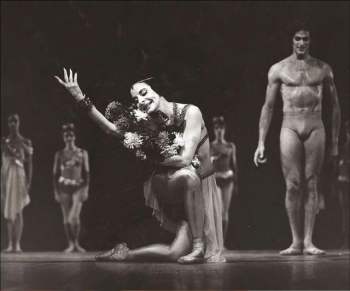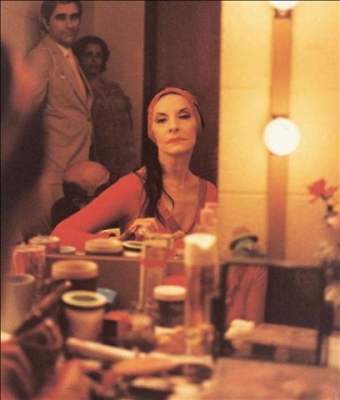Cuba’s Ballet in a Book
By Helson Hernandez

HAVANA TIMES, January 30— We interviewed Octavio Roca, the author of the book Cuban Ballet, which ventures onto the interesting terrain of ballet in Cuba, its principal figures and other testimonies about the development and history of this artistic form. The publication also includes amazing images that enrich its content.
HT: As the author of the book Cuban Ballet, it would be interesting if you explained the purpose of this publication and the idea that inspired this work, whose content is so valuable.
Octavio Roca: Above all, I produced this because I am Cuban. Though I live in the United States, I was born and raised in Havana. Also, it’s because the Cuban ballet is not only the first one that I saw as a child, it’s also the best I’ve ever seen. I have spent more than thirty years watching, enjoying and admiring ballet dancers from all over the world – an art form that I’ve critiqued professionally as a specialist for the Washington Post, the Washington Times, and the San Francisco Chronicle, for example. For me it has been an extremely exquisite spectacle to see how this small island of ours has exerted its influence on the development of international ballet.
Cuba’s influence gives me pleasure and pride, and with this book I want to share that pride with my readers. Currently Cuban ballerinas are like their Russian counterparts of the 1970s and ‘80s, and for very similar reasons. They have that type of strong but subtle influence; they can be found all over the world, and they’re always in first ranks.

If we analyze this we’ll find Cuban stars and teachers in companies like the American Ballet Theater (the Alma Mater of Alicia Alonso), the San Francisco Ballet, the Boston Ballet, the Miami Ballet in the United States, but also in the Royal Ballet of London, in Covent Garden, where Carlos Acosta reigns as the absolute king. In any of these instances you can find Cubans present.
They are defining the ballet of the new century, from New York to San Francisco, from Boston to London, and it sometimes seems that the whole world dances with a Cuban accent. It moved me a great deal that the great dancer Mikhail Baryshnikov wrote these words in the preface to my book: “I am certain that the love for Cuba that Octavio Roca carries is as deep as his knowledge of ballet, and I know that his book is from the heart.”
HT: Remind us what ties you had with the Cuban ballet and its principal figures, because obviously you develop themes in your work with which you seem to be very familiar. We also see you in photos with outstanding dance personalities who are not only Cubans.
OR: My book is a labor of love and a labor of memory. And although my love and my memories in themselves are not part of the story, they are part of how I was born. My mother, who danced with the Ballet de Pro Arte Musical in Havana, took me to my first ballet when I was five years old; we went to see Giselle, performed by Alicia Alonso and Igor Youskevitch. I suppose that when one begins with the best, it’s impossible not to fall in love with it. My very sincere affection for Alicia and for Cuban ballet has only deepened with the years and the distance.
HT: When was the idea of this book first kicked around? What were the circumstances in which Cuban Ballet emerged?

OR: I interviewed Alicia Alonso for the Washington Post for the first time in 1978, the same year that I returned to Cuba, but after so much time having passed since I’d been on the island. Alicia herself came up with the idea of me writing about her and her company. It took me a little while, but here it is.
Throughout all those years, the idea rested on the fact that Cuban ballet, like almost all Cuban arts, is constantly being reborn not only on the island but also outside it. From this came the main thread of the book. This book begins with the Alonsos and — though actually it is a story that continues to be written — it winds up with other outstanding figures such as Lorena and Lorna Feijoo, Joan Boada, Jose Manuel Carreño, Rolandito Sarabia, Taras Domitro and many more. The complete story has to not only include figures who are in Cuba but also those who are outside of it – Cubans all.
HT: What caught my attention was that in your book controversial issues converge concerning figures and testimonies related to the Cuban ballet. In the first pages are a foreword by Alicia Alonso, the highest representative of this art form in Cuba, and a preface by Mikhail Baryshnikov, another of the world ballet greats. Why did you choose these two personalities to preface your work? Was there some special motivation in this respect?
OR: First of all their inclusions work, and they work very well. The inclusion of Alicia Alonso, who with immense generosity wrote a beautiful preface to my book, was of course necessary because of the simple truth that without her what we call Cuban ballet wouldn’t exist. The inclusion of Mikhail Baryshnikov, the famous Russian dancer who I adore and whom I’ve known since he began his career in the United States, is also obvious. Among other things it was because he is a genius of the ballet, someone at Alicia’s level. In addition, though his ideology is completely different, he admires Cuban ballet and respects it with true affection. Ballet spans all political borders, and that’s the idea I was trying to express.
HT: This book is coming out the same year that Cuba is celebrating the 90 birthday of the greatest exponent in the history of classical ballet: Alicia Alonso. Was that by chance or did it have to do with publishing considerations?

OR: If my book can add a voice to the praise of this beautiful anniversary, even if a small one, then let it be.
HT: What can you tell us about the chapter that begins on page 114?
OR: That chapter is titled “Cuca’s Story,” and “The Paris Incident” and it tells a story. It’s initially about Alicia’s sister and later recounts the well-known adventure of the first group of Cuban dancers that decided to take a big leap toward their dreams – to Paris. Those stories, sadly, are not the only ones. In revealing these and other stories, my aim was inspired by the great thinker Jean-Paul Sartre, who worked all his life to discover the answer to a question of great importance: how one can know the complete life of someone else, be it Flaubert or Genet, or be it Alicia Alonso or Lorena Feijoo. My story of the Cuban ballet is like a novel, except in this case it’s all true.
HT: The photographs that are collected in the book are of incalculable value. Some of the images are quite old while others are contemporary, but they all sum up an intense amount of archival and research work. I can’t imagine how you were able to capture so much diversity over the span of generations.
OR: With a great deal of affection, and with a great deal of luck.
HT: In the book we find the remarkable presence of the Feijoo sisters, Lorna and Lorena, two of the great dancers produced by the Cuban school of ballet. Why did you choose them specifically, knowing that there are many artists of the Cuban ballet who decided to pursue international careers outside of their country? Others have also achieved success, triumphing as the principal figures in companies that are recognized around the world.
OR: There are very few ballet schools, especially today, when there is so much uniformity in the arts. But the Russians still look Russian, the English come off as English, and the French are as unique as always. The Cuban school of ballet is the youngest on the international scene, and currently it’s perhaps the liveliest. It’s enchanting. Cuban dancers, both in Cuba and overseas, project a regal and unique school.
It’s a synthesis — like Alicia explains in her preface to my book — of the best in the Russian, Italian and English schools, always tinged with a tropical flavor. It’s impossible not to note that they’re Cuban when some of these dancers come on stage; dancers like Lorena Feijoo, Lorna Feijoo, Joan Boada, Osmay Molina, Rolandito Sarabia or Jorge Esquivel himself (at sixty years of age).

They dance with their whole bodies, and they also dance with their souls. That’s exactly what Baryshnikov expressed in his preface when he wrote that this is what makes Cuban dancers stand out; it’s a respect for ballet from when they’re very young. He also wrote: “It’s been said that no one was born a dancer. It’s necessary to want to be one more than anything in the world, and these Cubans are like that; they know full well what a privilege it is to be a part of this art.”
HT: Was the book published only in English? I ask this because many ballet fanatics in Cuba will want to deepen in their knowledge.
OR: The publishing house that put out this book is based in the United States, where I live. But of course I’d be very interested in publishing The Cuban Ballet as El Ballet Cubano if clear proposals were to appear.
HT: As you define Cuban ballet, you‘re referring not only to what is being increasingly developed with greater force in Cuba, but also to that which represents us in many other corners of the world, wherever there’s an artist from the island exhibiting the wealth of our peculiar way of approaching dance.
OR: The Cuban ballet, the company that is today called the National Ballet of Cuba, was founded by Alicia Alonso, Fernando Alonso and Alberto Alonso in 1948. It always had its ballet school, its unique style of not only dance but of pedagogy. It existed before the revolution, and I have complete faith that it will continue to exist.
It’s curious but true that the whole population of Cuba is not so large, because our island is not that big. But Cuban art is indeed grand, and Cuban ballet is so immense, so beautiful. There are many reasons; and many of those people who have contributed to its development and to each artist has an unforgettable story. My book is that story. It’s a story of tragedy and of hope and of the return of many artists someday. Like I said, it’s a complete novel – but everything in it is true.





